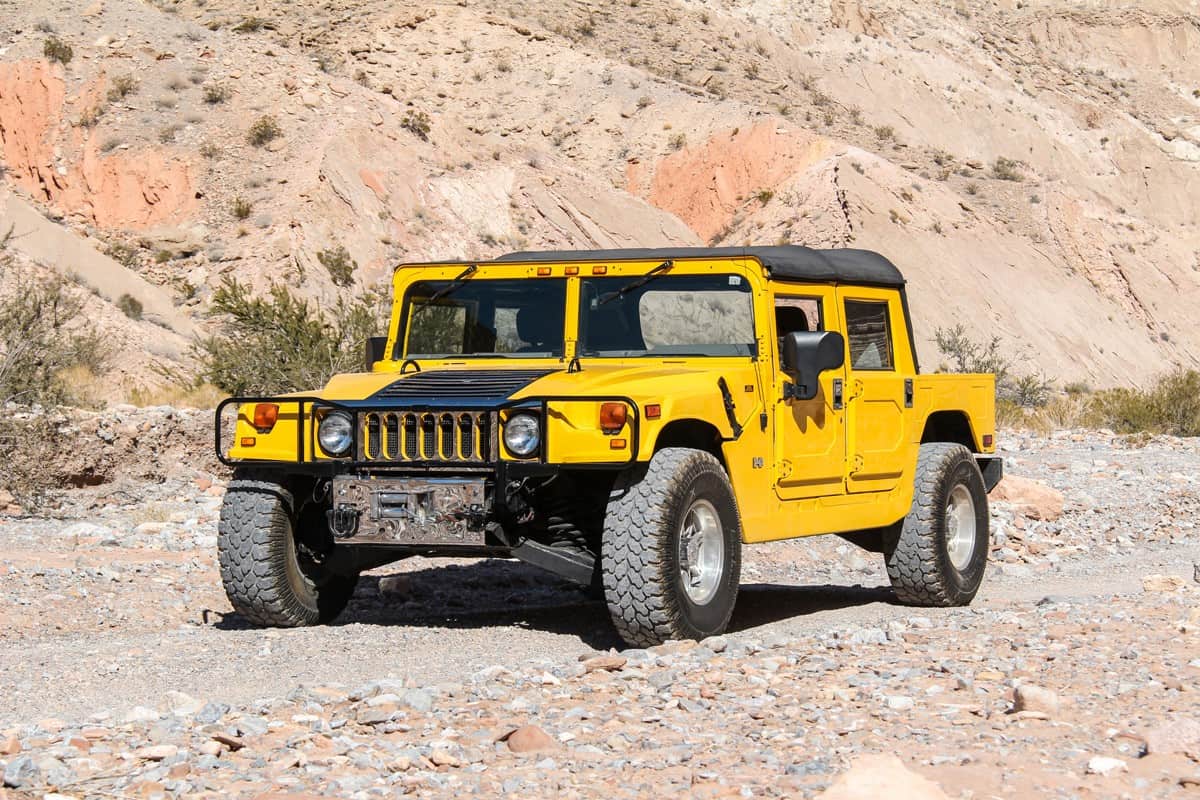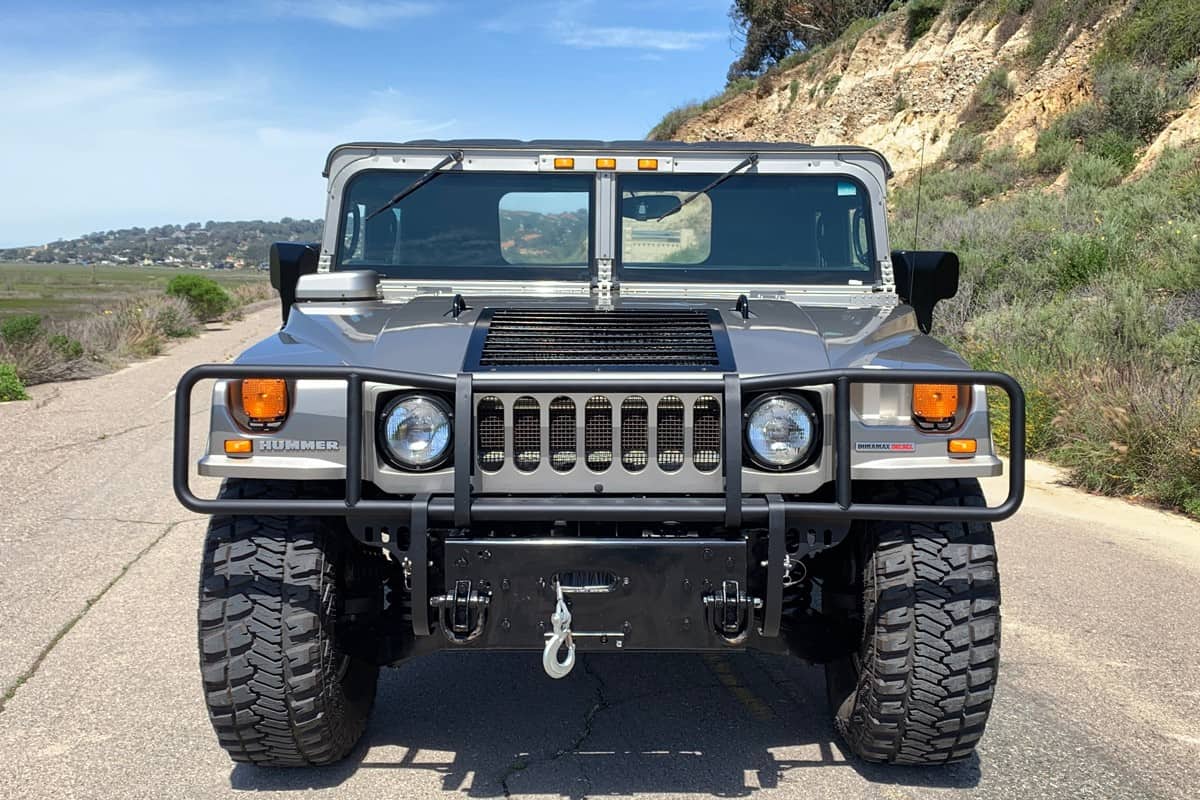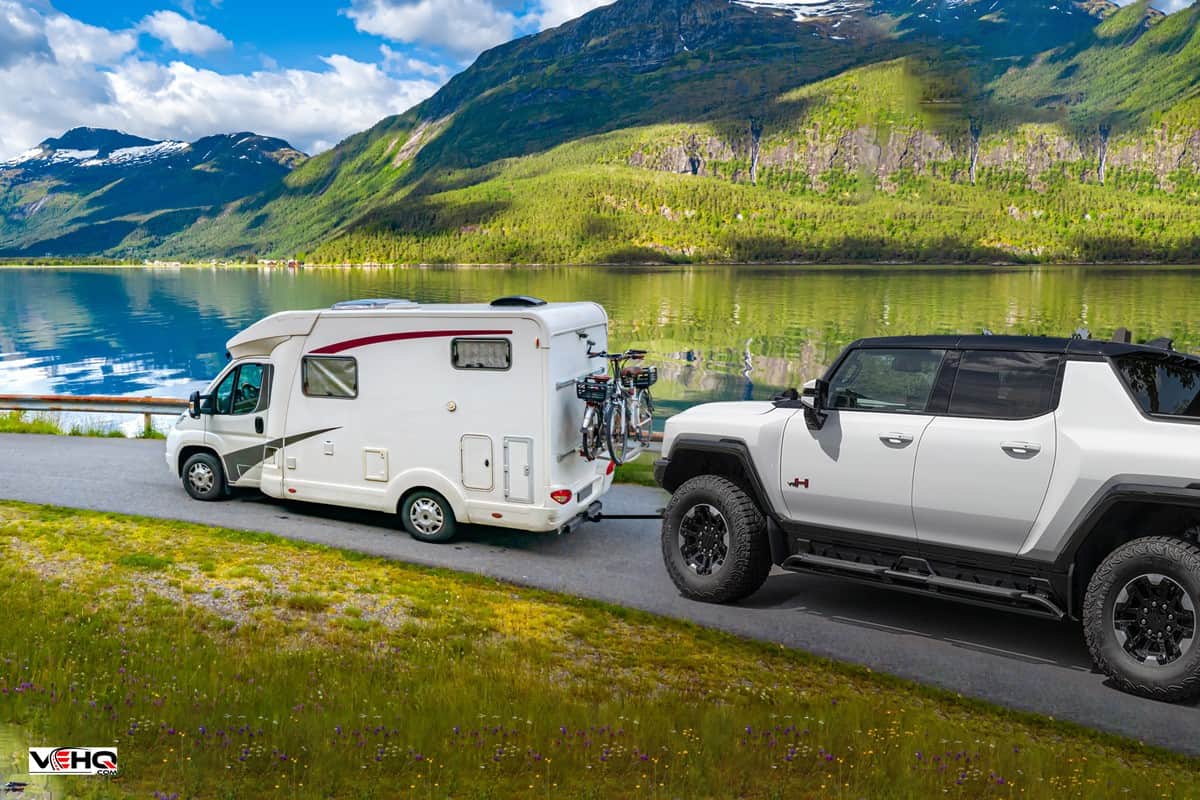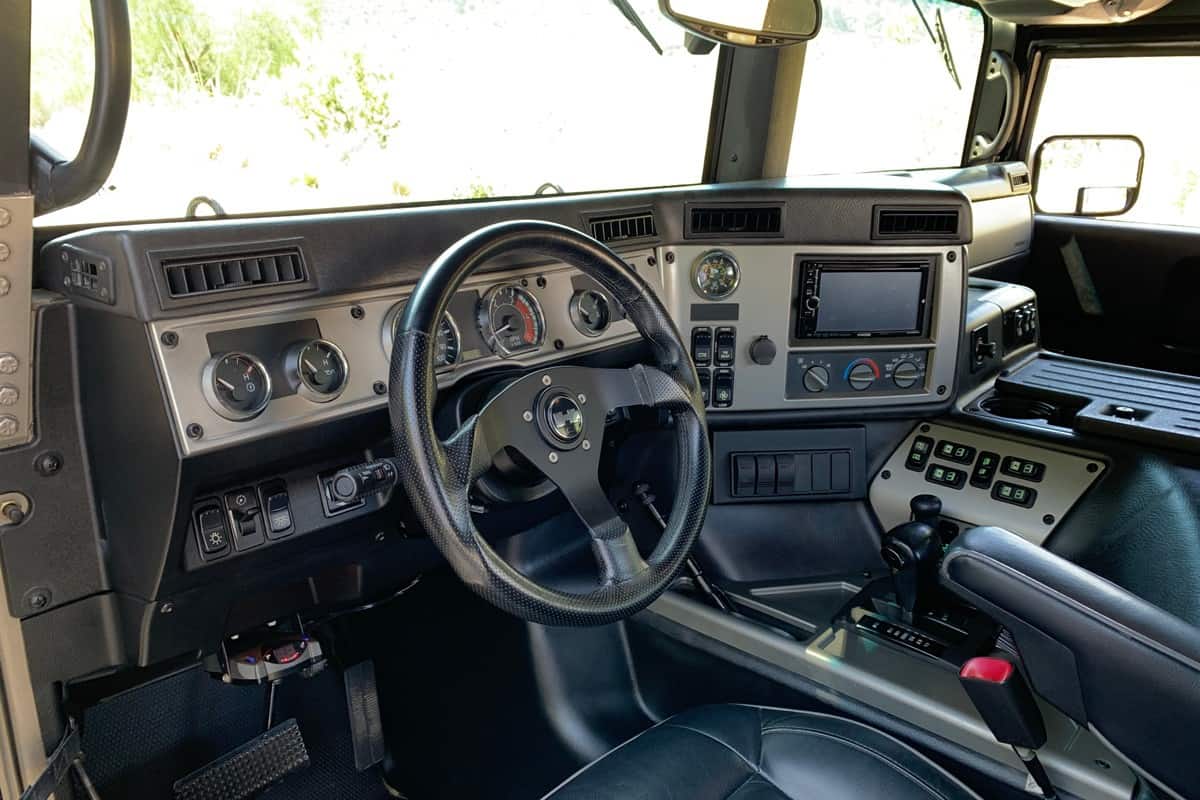Although the Hummer H1, H2, and H3 have been discontinued for over a decade now, some collectors and enthusiasts still regard these vehicles highly for their uncommon design and off-road capability. A critical component of these vehicles' trail readiness is the 4x4 drive system. So how do you use the 4x4 system on these Hummers? Here's what our research has uncovered.
All Hummers use a full-time four-wheel drive (4WD) system, which means that all four wheels have power all the time that you drive a Hummer. However, you can shift the drive operation to 4High, 4High Lock, 4Low Lock, and Neutral as long as you follow the necessary procedures and vehicle speeds during the shift.
Would you like to know more about how to use the 4x4 system on the Hummer H1, H2, and H3? Do read on, because we've also included the driving situations when each of these drive modes will be highly useful or recommended.
Is The Hummer H1 4WD?

The Hummer vehicle line is one of the most iconic American vehicle nameplates of all time. The H1, H2, and H3 are actually the civilian descendants of the U.S. military's 4WD High Mobility Multipurpose Wheeled Vehicle, popularly known as the M998 Humvee.
The Humvee gained popularity among several branches of the U.S. military due to its capability to transport troops and cargo over harsh terrain. This tactical vehicle proved its mettle in the 1991 Gulf War, and cemented its place in history as the rightful successor to the legendary but aging Jeep.
Although the Humvee's manufacturer, AM General, had plans to create a civilian version of the Humvee since the 1980s, the Hummer H1 only made its market debut in 1992. It was the actor-turned-politician Arnold Schwarzenegger's insistent lobbying that helped persuade the automaker to pursue this business decision.
The Hummer H1 provided much more creature comforts in the cabin compared to the Humvee. However, underneath the body, the two vehicles are almost identical. Because it had the same transmission, transfer case, differentials, and axle shafts as the Humvee, the Hummer H1's 4WD system was essentially the same.
The Hummer H1 uses a full-time four-wheel drive system that uses torque-sensing (Torsen) differentials to direct power to specific wheels depending on the available traction. To shift the H1 between different drive operations, you will need to use the transfer case range selector lever just beside the transmission selector lever.
How Do You Put A Hummer In 4 Wheel Drive?
With the Hummer H1's full-time 4WD, you can select from different transfer case operating modes for on-road and off-road vehicle use.
- High (H) - This mode works best for smooth or paved road surfaces, but can also be used on mild off-road situations as the driver desires. The H mode should be the default operation for most city and highway driving situations.
- High Lock (HL) - The High Lock mode works well for paved but low-traction surfaces, such as snowy, icy, muddy, or sandy terrain. The HL mode, however, should not be used for extended periods of normal driving situations as this would cause excessive tire wear and possible drivetrain damage. According to the Hummer H1 manual, you can shift the transfer case range selector from H to HL at any legal speed without shifting the transmission selector to neutral.
- Low (L) - The Low mode is suitable for low-speed, off-road driving situations, like when driving up a steep slope, climbing a boulder or wall, or traversing through deep snow, mud, or water. Before you shift the transfer case selector lever to Low mode, you will need to stop the H1 and shift the transmission selector to Neutral. When in Low mode, you should not drive the Hummer H1 beyond 31 mph (50 km/h).
- Neutral (N) - The Neutral mode disconnects the transfer case to allow the vehicle to be flat-towed behind another vehicle.
Does Hummer H1 Have Lockers?

The Hummer H1 does not have a true locking rear differential. The H1's Torsen differentials may be capable of transferring up to four times the torque from one wheel to the other on the same axle when it senses that a wheel is about to slip. However, when one of the wheels is already up in the air, both wheels on the same axle will not receive any torque.
To maximize the available torque on one wheel, however, the H1 uses a brake traction control system. When one wheel slips (or is up from the ground), the system applies brakes to that raised wheel and allows the Torsen differential to deliver more torque to the opposite wheel on the same axle.
How Do You Turn On The 4x4 On A Hummer H2?
Like its bigger H1 brother, the Hummer H2 also has a full-time 4WD system. However, the H2 comes with an open front differential and an Eaton rear differential locker to help the vehicle get out of low traction situations.
The H2 may come with a transfer case dial or a set of transfer case selector buttons, depending on the trim or year model. Regardless of the transfer case selector design, the H2 comes with five different operating modes.
- Full-time Four-Wheel Drive (4H) - same as the H1's "High".
- Four-Wheel-High Lock (4H Lock) - same as H1's "High Lock". You may shift between 4H to 4H Lock only if your H2 is traveling below 40 mph (64 km/h). After turning the dial/pressing the button to select 4H Lock, an indicator light on the selector will blink while the transfer case shifts. Once shifting is complete, the light will remain steady.
- Four-Wheel-Low Lock (4L Lock) - same as the H1's "Low". To shift to 4L Lock, the H2 needs to be stopped or traveling at no more than 3 mph (5 km/h) with the transmission selector in Neutral. After turning the dial or pressing the button selector for 4L Lock, wait for the indicator light to blink and then stay lit before putting the transmission in gear.
- Rear Axle Lock - gives the vehicle additional traction during certain off-road situations. To lock the rear axle, you must first shift the transfer case to 4L Lock. After the shift to 4L Lock finishes and with the vehicle moving at no more than 2 mph (3 km/h), press the Rear Axle Lock button. A corresponding indicator light will flash for a few seconds before remaining steadily lit to indicate a successful locking of the rear axle.
- Neutral - same as H1's "Neutral"
How Do You Use The 4x4 On A Hummer H3?

The Hummer H3 and H3T (pickup version) have full-time 4WD systems that operate almost exactly the same way as that of the H2. However, there are a few differences and additional features.
First, the H3 can shift between 4H and 4H Lock even when the vehicle is traveling at speeds up to 75 mph (120 km/h). Second, the H3 not only has a rear axle locking feature, but also a front axle locking mode. Finally, the axles can be locked even when the vehicle travels up to 16 mph (26 km/h).
Locking the front axle along with the rear axle gives the Hummer H3 even more traction that it may need to get itself out of extremely challenging off-road situations. You may lock the front axle only after meeting the following conditions:
- The vehicle is in 4L Lock mode
- The rear axle has already been locked
Locked axles will automatically disengage when:
- You drive the vehicle beyond 40 mph (64 km/h)
- The H3's 12-volt battery gets low on charge
- The transfer case mode is not in 4L Lock anymore
Can You Flat Tow A Hummer?

Here are the steps to set up a Hummer for flat towing.
- Start the engine and align the Hummer's front to the back of your RV.
- Shift the transmission to park (P) or 1st gear, depending on the transmission type.
- Keep the brake pedal pressed and turn the engine off, but keep the ignition in the "On" position. Set the parking brakes.
- Attach the Hummer to the tow vehicle using the proper towing equipment.
- Shift your Hummer's transfer case to neutral (N) mode. See the following section for more details.
- Release the parking brake and keep the ignition in the "Accessory" or "On" position. You may flat tow your Hummer safely now.
How Do You Manually Put A Transfer Case In Neutral?

With the engine running and the parking brake set, follow these steps to shift your Hummer's transfer case to Neutral.
- Shift the transmission selector (or gear shift lever for M/T) to neutral.
- Select Four Wheel High on the transfer case selector.
- Press the Four Wheel High and Four Wheel Low Lock buttons at the same time for 10 seconds.
- Wait for the "N" indicator light to blink repeatedly and then remain lit to indicate the transfer case's successful shift to Neutral mode.
- To double-check if the transfer case has indeed entered Neutral mode, step on the brake pedal and shift the transmission to drive and to reverse. The Hummer should not jolt forward or backward.
- Turn off the engine but leave the ignition in the "Acc" position so that the steering wheel will not lock up.
- Shift the transmission lever to park (P) for A/T or first gear for M/T.
Wrapping Up
You can select different 4WD modes on your Hummer through the transfer case range selector. This can be done with a twist of a dial or a press of a button, depending on the model and model year. However, always follow the procedures and the speed limits carefully when shifting between 4WD modes.
Thank you very much for reading. We hope we were able to help you familiarize yourself with the 4x4 drivetrain options on Hummer vehicles.
For more interesting reads about Hummers, drivetrains, and other automotive topics, check out these articles below.
Can You Flat Tow A Hummer H2 Or H3?
